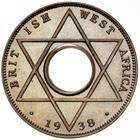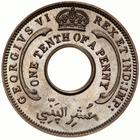One-tenth Penny (CuproNickel, George VI), Coin Type from British West Africa - detailed information
| ||||
The British West African Pound was the currency of British West Africa, a group of British colonies, protectorates and mandate territories - Nigeria, Sierra Leone, Ghana (originally Gold Coast) and Gambia. The British West African Pound was equal to the (pre-decimal) Pound Sterling and was similarly subdivided into 20 shillings, each of 12 pence. Unlike its Imperial counterpart though, the British West African Pound - uniquely among British colonies - also had a denomination worth one tenth of a penny - due to the low standard of living in the African colonies, where people had considerably less money than people elsewhere. The denomination was worth 1/2,400th of a pound (i.e., 2,400 of these coins made one pound). The earliest coins of this denomination were made of aluminium; however, they suffered from corrosion and were soon replaced by this type in copper-nickel. After decolonisation, the coins were replaced by the various new countries as they introduced their own independent currencies: In some places, British West African coins circulated in parallel with the new coinage until 1968. | ||||
| ||||
| ||||
| ||||
| ||||
 |
| Buy Silver Coins Online |
 |
| Buy American Gold Buffalo Coins |
| Country | British West Africa |
|---|---|
| Currency | British West African Pound |
| Sub-type of | One-tenth Penny |
| From | 1938 |
| To | 1950 |
| Face Value | 1/10 (x Penny) |
| Current | No (demonetised 1968) |
| Material | CuproNickel |
| Designer | |
| Technology | Milled (machine-made) |
| Shape | Round with hole |
| Orientation | Medal Alignment (Axis 0) |
| Size | 20.0000 mm |
| Mass | 1.9000 g |
 |
| Buy Silver Bullion Online |
| Image | Details |
|---|---|

|
Proof Coin - 1/10 Penny, British West Africa, 1938
Copyright: Museums Victoria / CC BY Author: Jennifer McNair Notes: Common reverse (1938 - 1950). Source |

|
Proof Coin - 1/10 Penny, British West Africa, 1938
Copyright: Museums Victoria / CC BY Author: Jennifer McNair Notes: King George VI, Emperor of India (1938 - 1947). Source |

